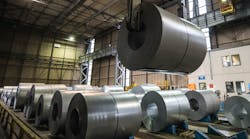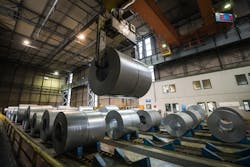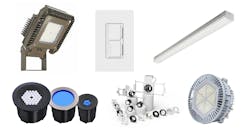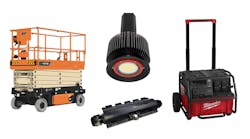American electrical equipment manufacturers over the past couple of months have been dealing with substantial increases in raw material costs in the face of new tariffs on imported steel and aluminum. Distributors say they’re already seeing increases in their costs for steel-intensive products, primarily in metal conduit, and expect to see more down the road.
On March 8, President Donald Trump signed an order imposing tariffs on imported steel at 25% and aluminum imports at 10% in a bid to slash U.S. trade deficits. Trump initially exempted Mexico and Canada from the tariffs as Washington seeks to renegotiate the North American Free Trade Agreement (NAFTA), then announced the U.S. would also suspend the tariffs on the European Union, Australia, South Korea, Brazil, and Argentina until May 1.
South Korea struck a deal in late March to open its automotive market to U.S. manufacturers in return for exemption from the tariffs. Brazil and Argentina also made agreements to avoid the tariffs. Hours before the May 1 deadline, the White House announced another month’s extension to June 1 for imports from the European Union, Canada, and Mexico.
All this uncertainty about the price of critical materials for U.S. manufacturing has already begun to show up in price increases, according to distributors who have responded to a question about tariffs in Electrical Wholesaling’s annual Top 200 survey. Some respondents have seen increases of as much as 20% to 50% in the prices they pay for conduit and strut. Others said they haven’t seen the impact yet. One mentioned that his OEM customers are running into steel availability problems.
One Texas distributor interviewed for this story said he wasn’t surprised to see the increases. He asked not to be identified out of concern for his supplier relations.
“Manufacturers have been struggling to get price increases for the past few years,” he said.
Now the news of tariffs along with widely seen increases in shipping costs nationwide have given them stronger justification. “Everybody takes advantage of a good crisis, especially the steel pipe people. They’re very aggressive on it, but we’ve seen it across the board,” he said.
Meanwhile everyone in the electrical supply channel is watching to see how the market responds to the higher costs. The Texas distributor said he’s seeing people scrambling to lock in blanket contracts to secure supplies before prices increase further, but he hasn’t seen anyone concerned about shortages.
“These price increases are pretty fresh, and we think we’re going to be able to get away with passing it along,” he said. “It’s obviously in our best interest to raise prices, but only if our competitors are doing it. The expectation now is that it will probably get through the system.”
Shortly after the initial tariffs were announced in March, U.S. electrical manufacturers told Electrical Marketing that steel prices were already going up and now are expected to rise more. Meanwhile, foreign producers of competing finished products made where the raw materials aren’t taxed gain a significant advantage.
The 10% tariff on aluminum won’t do much to change the economics of aluminum wire, said Greg Lampert, president of wire master distributor Omni Cable, West Chester, Pa., though he remains wary. Smelters are heavily dependent on the price of energy, which makes up a third of their costs, and finished wire imported from countries with cheap power won’t be affected by the tariff on raw materials.
“Aluminum wire manufacturers have already seen an onslaught of new competitors importing wire, and the importers are ramping up their positions. Domestic suppliers would love to move the price up 4% or 5%, but if the tariff isn’t going to be enforced on finished product from countries with cheaper sources of energy, it’s not going to affect the market at all,” he said.
John Mothersole, director of pricing and purchasing service for IHS Global Insight, and his team had to issue a new version of their first-quarter metals market forecast after the one released a few weeks before was nullified by the President’s tariff announcement two days later.
He said aluminum markets saw a surge in imports after the tariffs were announced and the closely watched Midwest Delivery Premium, the price on top of the London Metals Exchange commodity price buyers must pay to get prompt delivery, went from 7 to 8 cents per pound in October to 20 cents in late March.
“We thought the premium would peak at about 19 cents per pound but the market has overshot where prices were going to go,” he said.
Mothersole said steel market analysts in his firm have begun to see instances of companies warning about allocations or placing customers on allocation.
“That’s a recipe for spiking prices,” he said.
He is also watching closely as trade officials in Washington work through negotiations with other countries.
“The list of countries that are likely to be exempted from the tariffs has grown,” Mothersole said. “Now you’re driving a big hole in this tariff wall.”
He still expects enough of a supply gap under the tariffs to allow domestic producers to charge customers near the full tariff amount.
The National Electrical Manufacturers Association (NEMA) responded to the tariff announcement with a statement from association resident and CEO Kevin Cosgriff that the new import tariffs on steel and aluminum would create unwelcome challenges for many electrical manufacturers, particularly related to certain types of electrical steel not made in the U.S. and what he termed overly broad restrictions on imported aluminum.
“Our industry uses steel and aluminum from domestic and overseas sources in their manufacturing processes. The President’s decision to impose import taxes on fairly traded steel and aluminum will not help our manufacturers’ costs or aid them in being more competitive in the global economy,” said Cosgriff. “We believe the opposite to be the case.”
The Associated General Contractors (AGC) said price increases were already accelerating for many construction materials over the past two years, and the imposition of tariffs put projects and the contractors who build them at risk. The group said in a release that the new tariffs will raise costs for firms, many of which are locked into fixed-price contracts with little ability to charge more for their services.
“Contractors will be forced to pass these cost increases along in bid prices, but that will mean fewer projects get built,” said AGC chief economist Ken Simonson in a release. “And contractors that are already working on projects for which they have not bought some materials are at risk of absorbing large losses.”




